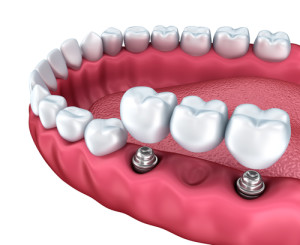 Does this graphic just look confusing? Keep reading to gain some implant insight
Does this graphic just look confusing? Keep reading to gain some implant insight
We spend a lot of time talking about how amazing dental implants are – but if you don’t know how they actually work, this probably sounds like a lot of nonsense. How do you replace lost tooth roots, and how can they support many different restorations? It’s all about the power of osseointegration.
No matter your age or oral health, dental implants could one day be a part of your life. Learn more about the process today to educate yourself on the possibilities, and also marvel at how far restorative dentistry has come. When we’re able to restore teeth in such a comprehensive way, everybody wins.
Dental Implants and Your Jaw
Natural teeth rise from your gums to erupt within your mouth. But if you delve below the gum line, you’ll find that each tooth is attached to a larger framework. Your jaw bone holds your teeth in place, and interconnects them with your facial structure.
When a tooth is lost, both crown and root are removed from the mouth. A dental implant takes on the role of the missing tooth root, reattaching to the same area. Implants are made from titanium, which is compatible with osseous tissue. As the months pass after its placement, it will gradually integrate with your bone, forming a new sort of tooth root. This is why implants must be placed surgically – they need to be able to reach your jaw bone to be effective.
There also needs to be enough bone in the area, which is why bone grafts are sometimes recommended for would-be implant patients. Once the area is strengthened, an implant will find a welcome and successful home there.
What Happens After the Implant Has Healed?
- An abutment is placed – This small post connects implants to restorations.
- Restorations are placed – Once you’ve healed adequately, the restorations are paired with the implants/abutments. Why the wait for healing? Because your implants need to be stable so that the jostling caused by chewing, biting and clenching doesn’t dislodge them from your jaw.
- You provide your restorations with ongoing care – You’ll need to brush, floss, and schedule regular exams to make sure your restorations stay disease-free and your implants remain successful.
- Your implants last for decades (or for life) – With proper care, your implants may stay with you for the rest of your life, helping your restorations feel and look just like natural teeth.
If you’re missing a tooth, implants will transform your daily life. Just get in touch to learn more about what they might accomplish for your smile.
